仁爱版七年级英语上册Unit1 Topic1 SectionB优质课教案
- 格式:docx
- 大小:17.63 KB
- 文档页数:6
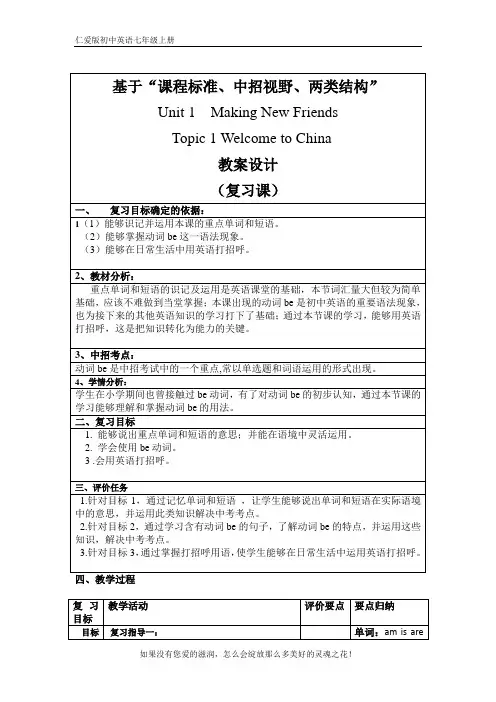
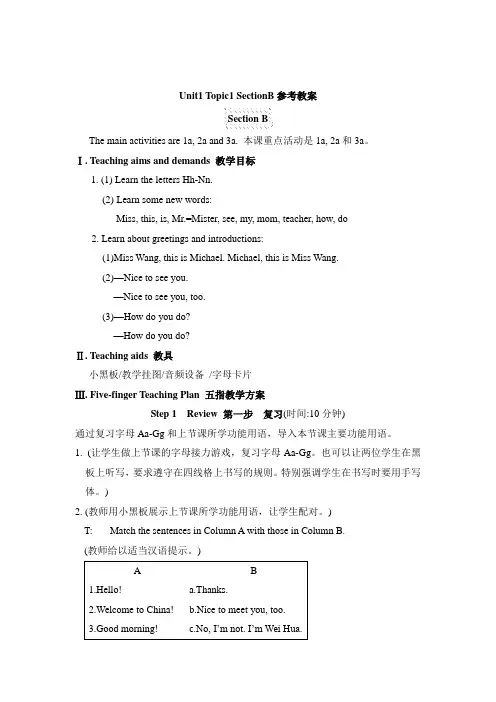
Unit1 Topic1 SectionB参考教案Section BThe main activities are 1a, 2a and 3a. 本课重点活动是1a, 2a和3a。
Ⅰ. Teaching aims and demands 教学目标1. (1) Learn the letters Hh-Nn.(2) Learn some new words:Miss, this, is, Mr.=Mister, see, my, mom, teacher, how, do2. Learn about greetings and introductions:(1)Miss Wang, this is Michael. Michael, this is Miss Wang.(2)—Nice to see you.—Nice to see you, too.(3)—How do you do?—How do you do?Ⅱ. Teaching aids 教具小黑板/教学挂图/音频设备/字母卡片Ⅲ. Five-finger Teaching Plan 五指教学方案Step 1 Review 第一步复习(时间:10分钟)通过复习字母Aa-Gg和上节课所学功能用语,导入本节课主要功能用语。
1. (让学生做上节课的字母接力游戏,复习字母Aa-Gg。
也可以让两位学生在黑板上听写,要求遵守在四线格上书写的规则。
特别强调学生在书写时要用手写体。
)2. (教师用小黑板展示上节课所学功能用语,让学生配对。
)T: Match the sentences in Column A with those in Column B.(教师给以适当汉语提示。
)A B1.Hello! a.Thanks.2.Welcome to China! b.Nice to meet you, too.3.Good morning! c.No, I’m not. I’m Wei Hua.(核对答案,教师讲解并让学生两人一组练习所学功能用语。
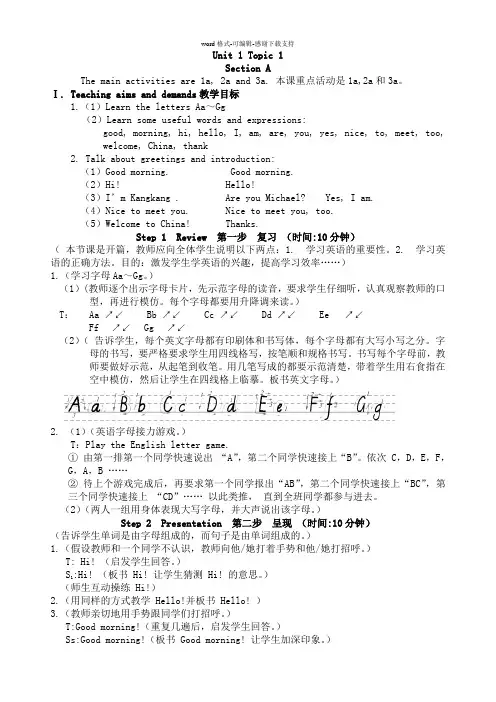
Unit 1 Topic 1Section AThe main activities are 1a, 2a and 3a. 本课重点活动是1a,2a和3a。
Ⅰ. Teaching aims and demands教学目标1.(1)Learn the letters Aa~Gg(2)Learn some useful words and expressions:good, morning, hi, hello, I, am, are, you, yes, nice, to, meet, too,welcome, China, thank2. Talk about greetings and introduction:(1)Good morning. Good morning.(2)Hi! Hello!(3)I’m Kangkang . Are you Michael? Yes, I am.(4)Nice to meet you. Nice to meet you, too.(5)Welcome to China! Thanks.Step 1 Review 第一步复习(时间:10分钟)(本节课是开篇,教师应向全体学生说明以下两点:1. 学习英语的重要性。
2. 学习英语的正确方法。
目的:激发学生学英语的兴趣,提高学习效率……)1.(学习字母Aa~Gg。
)(1)(教师逐个出示字母卡片,先示范字母的读音,要求学生仔细听,认真观察教师的口型,再进行模仿。
每个字母都要用升降调来读。
)T: Aa ↗↙Bb ↗↙Cc ↗↙Dd ↗↙Ee ↗↙Ff↗↙Gg↗↙(2)(告诉学生,每个英文字母都有印刷体和书写体,每个字母都有大写小写之分。
字母的书写,要严格要求学生用四线格写,按笔顺和规格书写。
书写每个字母前,教师要做好示范,从起笔到收笔。
用几笔写成的都要示范清楚,带着学生用右食指在空中模仿,然后让学生在四线格上临摹。
板书英文字母。

Unit1Making New FriendsTopic1Welcome to China!Section BⅠ.Material analysis通过上节课的学习,学生们已经初步了解了一些表达问候和介绍的英语知识。
本课主要活动是1a和3a。
通过Maria和妈妈购物时偶遇Mr.Brown,并向他们互相介绍展开学习,同时,掌握有关问候和介绍他人的表达方式:“Nice to see you!”,“How do you do?”,“This is…”。
同学们继续学习字母Hh~Nn。
老师采用多媒体及游戏的教学方式展开本节课的教学活动,把课堂交给学生,使学生真正成为课堂的主人。
Ⅱ.Teaching aims1.Knowledge aims能够正确朗读并运用下列词汇:see,this,is,my,teacher,how,do,mom,dad,Miss;能够熟练读写字母Hh~Nn,并认识到字母有印刷体和书写体、大写和小写之分;能够用英语熟练表达问候和介绍他人:Nice to see you!How do you do?This is…2.Skill aims能听懂有关问候、介绍、辨认他人的表达方式;能运用表示问候、介绍、辨认他人的表达方式进行简单的交流;能正确地朗读对话,并能注意语音语调;能正确书写和使用大小写字母。
3.Emotional aims能够与同学积极合作,参与课堂活动,大胆实践;能够认真,规范书写英文字母和单词;能够有兴趣了解中外有关称谓的知识,并能在现实生活中积极实践。
Ⅲ.The key points and difficult points1.Key points正确使用表示问候、介绍他人的表达方法;正确书写Hh~Nn大小写字母。
2.Difficult pointsBe动词am,is,are的应用;称呼语Miss,Mr,Ms的区别和使用;大小写字母的转化。
Ⅳ.Learning strategies做游戏是学习英语的一种好方法。
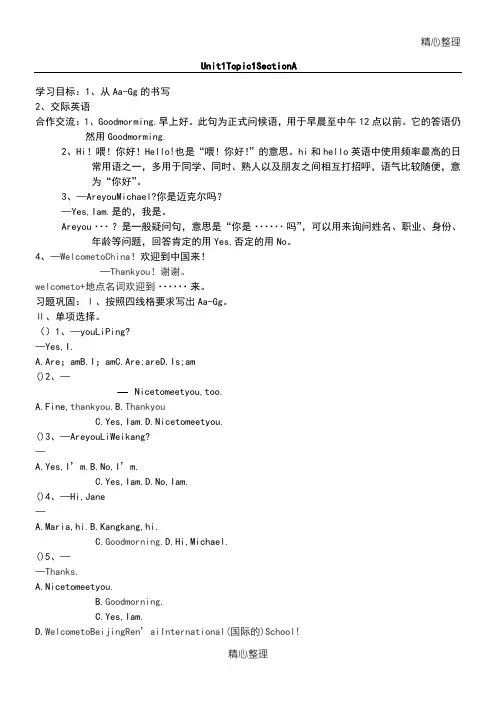
精心整理Unit1Topic1SectionA学习目标:1、从Aa-Gg的书写2、交际英语合作交流:1、Goodmorming.早上好。
此句为正式问候语,用于早晨至中午12点以前。
它的答语仍然用Goodmorming.2、Hi!喂!你好!Hello!也是“喂!你好!”的意思。
hi和hello英语中使用频率最高的日常用语之一,多用于同学、同时、熟人以及朋友之间相互打招呼,语气比较随便,意为“你好”。
3、—AreyouMichael?你是迈克尔吗?—Yes,Iam.是的,我是。
Areyou··年龄等问题,回答肯定的用Yes,4、—WelcometoChina!欢迎到中国来!—Thankyou!谢谢。
welcometo+地点名词欢迎到······来。
习题巩固:Ⅰ、按照四线格要求写出Aa-Gg。
Ⅱ、单项选择。
()1、—youLiPing?—Yes,I.A.Are;amB.I;()2、——A.Fine,thankyou.B.Thankyou()3、——A.Yes,I’m.()4、——A.Maria,hi.B.Kangkang,hi.C.Goodmorning.D.Hi,Michael.()5、——Thanks.A.Nicetomeetyou.B.Goodmorning.C.Yes,Iam.D.WelcometoBeijingRen’aiInternational(国际的)School!Ⅲ、从Ⅱ栏选出对应的答语。
ⅠⅡ()1.Goodmorning.A.Fine,thanks.()2.Hello!B.Nicetomeetyou,too.()3.Nicetomeetyou.C.No,Iamnot.()4.IamKangkang.AreyouMaria?D.Goodmorning.()5.Howareyou?E.Hi,Mr.Zhang.Unit1Topic1,SectionB 学习目标:1.字母的书写。

仁爱版英语七年级上册_仁爱版七年级英语上册unit1教案Unit1 Making New FriendsTopic 1 Section D一学习目标1 复习26个字母2 复习所学问候交际语言①Hi! Hello!②Good morning. / Good afternoon. ③How are you? / Fine,thank you. ④How do you do? / How do you do?⑥I’m ...Are you ...? Yes, I am. ⑦See you later. See you. ⑧Good-bye. Bye-bye.3 了解并记住五个元音字母,并根据其读音把26个字母分类。
4 be动词的用法和与主语的缩写形式。
二学习重点 : 本课重点活动是1,2和4。
三学习难点: 26个字母的书写规则、读音和 B e( am, is are ) 动词的用法四学习过程(一) 复习导入按顺序和正确的格式书写26个字母补全下列对话1. A:Good morning,Mr.Chen2. A.How are you ? . B: ,3. A: Good afternoon4. A: Nice to see you . .5. A: Are you Jane ? B: Yes, .6 A: Hello, Mr. Lee7 teacher, B: Mr. Li , this is my mother.8A: How do you do? B: ?(二 )自学指导( 1 )本节课主要是复习以前所学内容,看课文第八页4a部分,语法聚焦,这部分主要学习Be动词的简单用法和其于主语的缩写形式。
要牢牢掌握。
( 2 ) 制作自己的名字卡片,指导在英语中人名字的表达和书写格式。
( 3 ) 5 个元音字母:Aa Ee Ii Oo Uu( 4 ) 掌握读音/ei/ /i:/ /ai/ / / /ju:/ 并试着把26个字母按读音进行分类(三) 问题导学1. 26 个字母可以分为几类?2. 同学们会把下列汉语翻译成英语吗?早上好_______________ 下午好 ____________________你好 __________________ 你身体好吗?______________________ 我身体好,谢谢,你呢?_______________________________________你是康康吗?__________ 是的,我是。

Topic 1 Welcome to China. 教学设计主备人:夏丽红一、教学内容及分析1.内容:本课的内容是简单的英语问候表达方式以及能正确拼读和书写26个英文字母A到Z的学习,指的是会用Hello, Hi, Good morning,Good evening, Good afternoon,How are you? I'm fine, thanks.Welcome to..., How do you do?来和别人打招呼;能熟练的说出大写字母A到Z所对应的小写字母,能清晰的知道其大小写字母在四线三格上的规范书写及发音标准;其关键是区别这几种问候方式的不同用法并通过活动熟练掌握,另外还要会认读和书写26个英文字母。
理解它的关键就要鼓励学生大胆说和写英语,并从一开始就规范学生的发音和书写。
2.分析:学生在小学已经学过英文字母的读写,具有了学习本课知识的认知前提。
在此基础上,接着学习正确使用交际问候语,那么教学重点就是字母的读写,问候的口语交际,解决重点的关键是创设情境,在听说读写的活动中习得交际问候语,并让学生了解大小写字母的用法区别和中英姓名表示的区别。
二.教学目标及分析1.目标定位:掌握和理解单元的核心问候语;熟练掌握英文字母A到Z的拼读和书写。
了解大小写的区别和中英姓名表示的不同。
2.目标解析:掌握问候语就是指掌握Hello, Good morning,Good evening, Good afternoon,How do you do?How are you? I’m fine, thanks等问候表达方式并且区分好各种问候的回答。
掌握字母A到Z的拼读和书写就是指A到Z英文字母的大小写形式及所占的四线三格的位置并规范书写。
了解大小写的区别和中英姓名表示的不同就是指句首专有名词要大写,其他小写;中文姓前名后,英文名前姓后。
三、问题诊断与分析在本单元的教学中,学生可能遇到的问题是发音不准和书写不规范,产生这一问题的原因是因为学生对英语的语音特点还不够了解,书写操练还不够多。
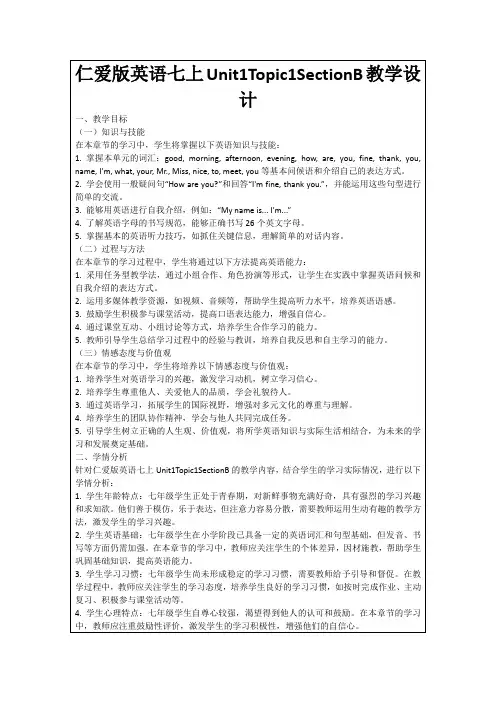
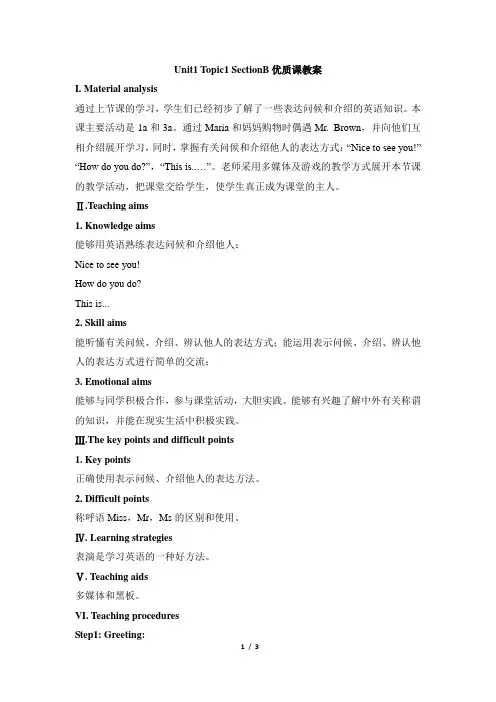
Unit1 Topic1 SectionB优质课教案I. Material analysis通过上节课的学习,学生们已经初步了解了一些表达问候和介绍的英语知识。
本课主要活动是1a和3a。
通过Maria和妈妈购物时偶遇Mr. Brown,并向他们互相介绍展开学习,同时,掌握有关问候和介绍他人的表达方式:“Nice to see you!”“How do you do?”,“This is..…”。
老师采用多媒体及游戏的教学方式展开本节课的教学活动,把课堂交给学生,使学生真正成为课堂的主人。
Ⅱ.Teaching aims1. Knowledge aims能够用英语熟练表达问候和介绍他人:Nice to see you!How do you do?This is...2. Skill aims能听懂有关问候、介绍、辨认他人的表达方式;能运用表示问候、介绍、辨认他人的表达方式进行简单的交流;3. Emotional aims能够与同学积极合作,参与课堂活动,大胆实践。
能够有兴趣了解中外有关称谓的知识,并能在现实生活中积极实践。
Ⅲ.The key points and difficult points1. Key points正确使用表示问候、介绍他人的表达方法。
2. Difficult points称呼语Miss,Mr,Ms的区别和使用。
Ⅳ. Learning strategies表演是学习英语的一种好方法。
Ⅴ. Teaching aids多媒体和黑板。
VI. Teaching proceduresStep1: Greeting:Step2. Review:1. Walk to one student to revise the greetings.T: Are you...?S: Yes, I am.T: Nice to meet you.S: Nice to meet you, too.2. Let students greet each other. And choose two groups to act out the conversation.Step3. The whole class work.1. Introduce several students to other students one by one, and present the new structure, “This is...” Then show some famous people on the screen who are familiar to students and say, “This is Mr./Ms./Miss...…” Tell students the difference among Mr, Ms. and Miss.2. Let students make up some new conversations in groups. And choose some groups to act out the conversation.●A: Hi, B…●B: … A! Nice to see you, too.●A: B, this is … C…●B: How do you do?●C: …Step4. Practice.1. Do 1b. Listen to the conversations and number the pictures.2. Do 1d. Complete the conversation and check the answers.3. Do 2. Answer the questions one by one. Then read.Step5. Summary.INTRODUCTION(介绍)This is...…GREETING(问候)Nice to see you!How do you do?Step6. Homework.Please collect the famous stars’ photos you like and introduce them to your classmates.Step7. Blackboard design:Section B1. This is... Mr.2. —Nice to see you. Miss—Nice to see you, too. Ms.3. —How do you do?—How do you do?教学反思本节课采用多媒体教学,能够增强学生的学习兴趣;通过做游戏和表演情景剧,能够调动学生学习的积极性和参与课堂的意识。
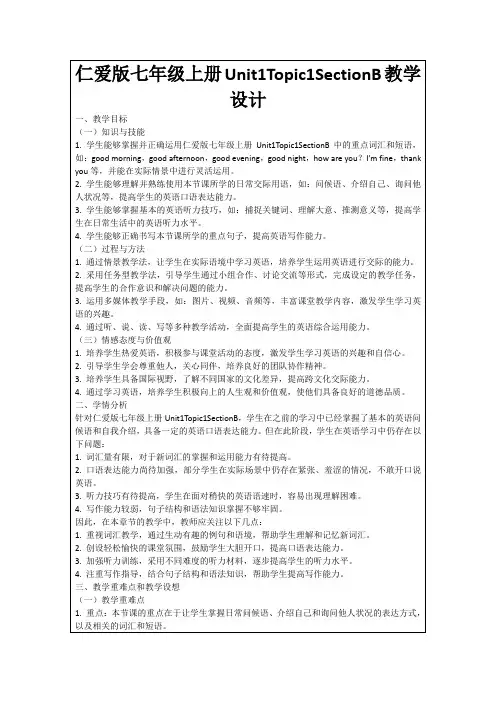
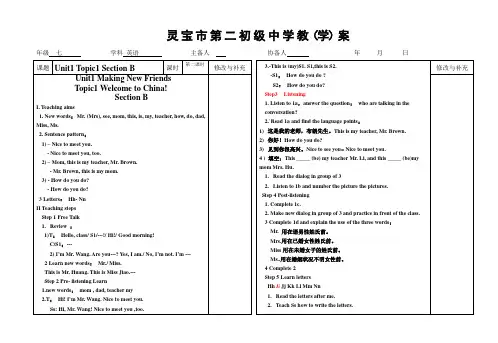
灵宝市第二初级中学教(学)案年级七学科英语主备人协备人年月日3.-This is (my)S1. S1,this is S2.修改与补充-S1:How do you do ?S2:How do you do?Step3 Listening1. Listen to 1a,answer the question:who are talking in theconversation?2.`Read 1a and find the language points:1)这是我的老师,布朗先生。
This is my teacher, Mr. Brown.2)你好!How do you do?3)见到你很高兴。
Nice to see you= Nice to meet you.4 ) 填空:This _____ (be) my teacher Mr. Li, and this _____ (be)mymom Mrs. Hu.1.Read the dialog in group of 32.Listen to 1b and number the picture the pictures.Step 4 Post-listening1. Complete 1c.2. Make new dialog in group of 3 and practice in front of the class.3 Complete 1d and explain the use of the three words:Mr. 用在语男性姓氏前。
Mrs.用在已婚女性姓氏前。
Miss用在未婚女子的姓氏前。
Ms..用在婚姻状况不明女性前。
4 Complete 2Step 5 Learn lettersHh Ii Jj Kk Ll Mm Nn1.Read the letters after me.2.Teach Ss how to write the letters.3.Explain: Ii 是元音字母。
优质资料---欢迎下载Unit 1 Making New FriendsTopic 1 Welcome to China!SectionA本课是仁爱英语七年级上学期Unit 1 Topic 1 Section A。
本单元教学内容以问候和介绍为中心,从了解姓名、互相问候到询问来自哪里、电话号码,再到谈论年龄、年级、班级等。
本课通过设置情景,如在机场、学校、户外等,学习问候、介绍、感谢和告别的句型,并要求学生学习、掌握A~G 7个英文字母。
一、引①让学生欣赏2008年北京奥运会主题曲《我和你》。
②让学生讨论2008奥运会对世界的影响及当今社会英语的重要性。
②学习如何问候他人和自我介绍,并根据幻灯片7的内容练习对话。
③听录音,完成1b。
三、探①听2a录音,让学生跟读并模仿语音语调。
②对话操练:模仿2a,与同桌进行对话,并表演。
③根据幻灯片里的内容进行两两对话。
四、点①听3a录音,让学生跟读并模仿语音语调。
②听录音,完成3b。
提醒学生所圈字母都含有相同音素/1/。
五、练英语字母接力游戏/字母配对游戏。
六、结让学生自己总结所学重点内容。
作业——①让学生想象和列举生活中形状与A、B、C、D、E、F、G这7个英文字母相似的物体。
②让学生为自己选一个英文名字。
Unit 1 Making New FriendsTopic 1 Welcome to China!Section B本课是仁爱英语七年级上学期Unit 1 Topic 1 Section B。
本单元教学内容以问候和介绍为中心,从了解姓名、互相问候到询问来自哪里、电话号码,再到谈论年龄、年级、班级等。
本课要求学生学习、掌握H~N 7个英文字母以及介绍他人和打招呼的交际用语。
一、引①从“Good morning”,“Are you ... ”。
二、学①呈现双向细目表,明确本节课的教学重难点的学习。
②跟读课文1a,并模仿语音语调。
③让学生用“This is ...”造句,并与同桌进行两两对话。
仁爱版七年级英语上册Unit1Topic1SectionB优质课教案Unit1 Topic1 Section B 优质课教案(贵州省)仁爱版七年级英语(教案)Unit 1 Making New FriendsTopic 1 Welcome to China!Section E贵州省剑河县第三中学李呈英I Teaching aims and demands教学目标1.Learn the meaning of open and close syllables in Chinese1)开音节绝对开音节:单个元音字母后面没有辅音字母的重读音节辅音+单个元音”结构相对开音节:以单个元音字母加单个辅音字母(r除外),再加上不发音的字母e构成的重读音节。
“辅音+单个元音+辅音+不发音的e”结构2)闭音节以元音字母加一个或几个辅音字母结尾的重读音节。
2. Learn about the rules of pronunciation of vowel letters and consonants .在开音节里,元音字母读字母本身音,a发/e?/; e发/i?/; i发/a?/; o 发/??/; u发/ju?/或/u?/;在闭音节里,元音字母a 发/?/; e 发/e//; i 发/?/;o 发/?/;u发/?/。
因此,在入门阶段的英语学习中,听到字母本身音,就按开音节结构拼写单词,听到/?/;/e/;/?/;/?/;/?/就按闭音节结构拼写单词。
3.Overcome students’ fear of remembering English words and develop students’ confidence to learn English well.Ⅱ. Teaching difficult and important points:1. the meaning of open and close syllables in Chinese2. the rules of pronunciation of vowel letters and consonants3.how to spell English words according to the rules of pronunciation of vowel letters and consonantⅢ.Teaching aids 教具投影仪IV. Five-finger Teaching Plan 五指教学方案Step 1 Revision第一步复习(时间:4分钟)1 Introduction 介绍本节课是一堂学习能力的提升课,教师应向全体学生说明:在没有语言环境和缺乏现代设施的的城镇里,我们只要学好字母在单词里的发音,我们就能按读音来拼写单词,即使是我们从来没有见过的单词,我们也能根据读音写出来,使学生树立起英语单词的拼写比汉字简单得多的理念。
Unit 1 Making New Friends课程名称: u1 T1 Welcome to China!教学内容:问候语,介绍自己,大小写,认识外国人姓名教学对象:仁爱版初一学生教学目标:1.会用英语熟练的与人问候,介绍自己教学重难点:问候语Teaching StepsStep 1: Leading-in上课和学生用英语打招呼,并启发学生用多种方式问候Step 2: Warming-up老师自我介绍,并让学生自我介绍,让学生回忆单词Step 3: Teaching and Drills知识卡片11.问候语1)Good morning!早上好Good afternoon!下午好Good evening!晚上好Good night!晚安以上四句话的回答都是一样的Good morning!用于正式语中,在非正式用语中可以将good省略。
2)Welcome to+地点名词:欢迎来到...答语可用Thank you./Thanks.3)见到某人可用1. Nice/ Glad to see/ meet you.回答用:Nice/ Glad to see/ meet you, too.2.How do you do?答语用:How do you do?3.How are you?答语用:Fine, thank you. And you?4)再见可用1.See you then/ later.答语用:See you.2.Goodbye.答语用:Bye.2.问候语Are you...请问你是...吗?(用升调),可用来问别人的姓名,年龄,职业回答用:Yes,I am./No,I am not.例1)--Are you a teacher?--Yes,I am.2)--Are you 12 years old?--No, I am not.3.外国人名字的认识中国:姓+名李明外国:名+性John Smith (John为名:first name, Smith为姓:family name) 练习指出下面的first name and family nameJim GreenLily Wang总结课程名称:U1 T2 Where are you from?教学内容:Be动词,如何询问别人年龄、电话号码、家乡、班级教学对象:仁爱版初一教学目标:能够熟练掌握be动词的用法教学重难点:be动词的用法Teaching StepsStep 1: Leading-in由学生翻译我是Lily他是John你是Han MeiStep 2: Teaching and Drills知识卡片1Be动词1.基础定义:“Be动词”原形是“be”,此外,还有其他形式形式:am, is, are2.用法我用am,你用are,is用于他、她、它,单数用is,复数就用are。
Unit1 Topic1 Section B 优质课教案(贵州省)
仁爱版七年级英语(教案)
Unit 1 Making New Friends
Topic 1 Welcome to China!
Section E
贵州省剑河县第三中学
李呈英
I Teaching aims and demands教学目标
1.Learn the meaning of open and close syllables in Chinese
1)开音节
绝对开音节:单个元音字母后面没有辅音字母的重读音节
辅音+单个元音”结构
相对开音节:以单个元音字母加单个辅音字母(r除外),再加上不发音的字母e构成的重读音节。
“辅音+单个元音+辅音+不发音的e”结构
2)闭音节
以元音字母加一个或几个辅音字母结尾的重读音节。
2. Learn about the rules of pronunciation of vowel letters and consonants .
在开音节里,元音字母读字母本身音,a发/eɪ/; e发/iː/; i发/aɪ/; o 发/əʊ/; u发/juː/或/uː/;在闭音节里,元音字母a 发/æ/; e 发/e//; i发/ɪ/;o 发/ɒ/;u发/ʌ/。
因此,在入门阶段的英语学习中,听到字母本身音,就按开音节结构拼写单词,听到/æ/;/e/;/ɪ/;/ɒ/;/ʌ/就按闭音节结构拼写单词。
3.Overcome students’ fear of remembering English words and develop students’ confidence to learn English well.
Ⅱ. Teaching difficult and important points:
1. the meaning of open and close syllables in Chinese
2. the rules of pronunciation of vowel letters and consonants
3.how to spell English words according to the rules of pronunciation of vowel letters and consonant
Ⅲ.Teaching aids 教具
投影仪
IV. Five-finger Teaching Plan 五指教学方案
Step 1 Revision第一步复习(时间:4分钟)
1 Introduction 介绍
本节课是一堂学习能力的提升课,教师应向全体学生说明:在没有语言环境和缺乏现代设施的的城镇里,我们只要学好字母在单词里的发音,我们就能按读音来拼写单词,即使是我们从来没有见过的单词,我们也能根据读音写出来,使学生树立起英语单词的拼写比汉字简单得多的理念。
目的:培养学生战胜困难的成就感,激发学生学习英语的兴趣和热情。
2. Revise the sounds of vowel letters and consonants:
Let the students recall and read the sounds of vowel letters and consonants one by one on the screen.
Step2 Presentation第二步呈现(时间:20分钟)
1. Let Ss look and listen to the tape, perceive(感知) the pronunciation of vowel letters.
2. Read, observe and find out the spelling rules:
T: Read and observe the words in the first row carefully.
T:what can you find?
S1:
S2:
1)Lead the Ss to find out and sum up the rules of pronunciation of vowel letters:
a.所有第一排的词都含有/ i: / 音(读音上)。
b.所有的词都是单个元音字母后面没有辅音字母(结构上)。
T: Read and observe the rest words carefully .
T: what can you find again ?
S1:
S2:
2)Go on leading Ss to find out and sum up the rules of pronunciation of vowel letters: a.第二排的词都含有/eɪ/ 音; 第三排的词都含有/aɪ/ 音; 第四排的词都含有/ əʊ/ 音; 第五排的词都含有/ /juː/音(读音上)。
b.四排中所有词都是由单个元音字母加单个辅音字母(r除外),再加上不发音的字母e构成(结构上)。
c. 归纳开音节的含义:
开音节:
绝对开音节: 单个元音字母后面没有辅音字母的重读音节。
“辅音+单个元音”结构
相对开音节:以单个元音字母加单个辅音字母(r除外),再加上不发音的字母e构成的重读音节。
“辅音+单个元音+辅音+不发音的e”结构
d. 归纳元音字母开音节词里的读音:a发/eɪ/; e发/iː/; i发/aɪ/; o 发/əʊ/; u发/juː/或/uː/
3)Lead the Ss to find out and sum up the rules of pronunciation of consonants.
a.第一排的词都含有/ æ / 音; 第二排的词都含有/ e / 音; 第三排的词都含有/ ɪ / 音; 第四排的词都含有// ɒ / 音; 第五排的词都含有/ ʌ / 或/ u音(读音上)。
b.所有的词都是由元音字母加一个或几个辅音字母结尾的重读音节(结构上)。
c. 归纳闭音节的含义:
闭音节:
以元音字母加一个或几个辅音字母结尾的重读音节.
d. 归纳辅音字母字母闭音节词里的读音:a 发/æ/; e 发/e//; i发/ɪ/;o 发/ɒ/;u发/ʌ/或/u/
结论:
在开音节词里,元音字母读字母本身音,a发/eɪ/; e发/iː/; i发/aɪ/; o 发/əʊ/; u发/juː/或/uː/;在闭音节词里,元音字母a 发/æ/; e 发/e//; i发/ɪ/;o 发/ɒ/;u发/ʌ/或/u/。
因此,在入门阶段的英语学习中,听到字母本身音,就按开音节结构拼写单词,听到/æ/;/e/;/ɪ/;/ɒ/;/ʌ/就按闭音节结构拼写单词。
Step 3 Consolidation第三步巩固(时间:6分钟)
1. Play a game. Show some words to Ss and ask them to find out which are open syllables and which are close syllables . Ss work in groups in two minutes .Which group is fast and right which group is the winner. The first will get 3 points, the second 2 points, the third 1point.
2. Read the following sounds and words.
Step 4 Practice 第四步练习(时间:10分钟)
1. Finish the following words according to sounds. Ss work alone first, then check and discuss the answers in groups to get right answers, teacher asks each group to tell their answers and explain why, the ones do well can get one point. 通过学生自己独立完成再到小组检查讨论得出正确答案来培养学生独立思考的能力和团队合作精神,激发学生的学习兴趣。
2.Lead the Ss to read the sounds and try to spell them according to the rules of pronunciation.
3.Read and write the words:
Ask the Ss to read the sounds, then spell the words according to their rules of the pronunciations of the letters.
Step 5 Project 第五步综合探究活动(时间5分钟)
Have a dictation
1.听写没学过的汉字:山旮旯傀儡
2.听写没学过的英语单词:sad(伤心的), hike(徒步旅行), hit(击), flote (长笛), wife(妻子), lift(电梯)通过对从没有学过的汉字和英语单词的听写,消除学生对记单词和学习英语的恐惧心理,培养和增强学生能学好英语的信心和决心。
板书设计:。